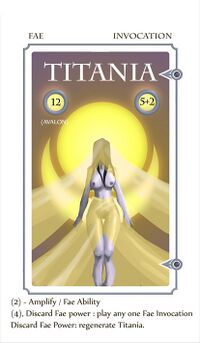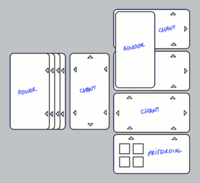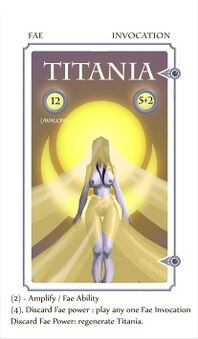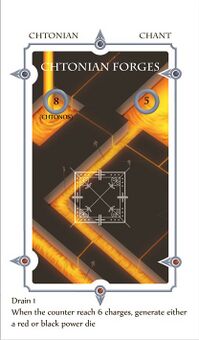Symphony of Aeons: Difference between revisions
1d4chan>NotBrandX No edit summary |
1d4chan>NotBrandX No edit summary |
||
| Line 51: | Line 51: | ||
* There must be enough room to place the card with a Power Entry adjacent to a matching Power Exit without overlapping any other card in the field. | * There must be enough room to place the card with a Power Entry adjacent to a matching Power Exit without overlapping any other card in the field. | ||
: Exception: when playing an Invocation that is identical to one already in the field, you must play the Invocation card to the same place. It will be placed on top of the existing Invocation card(s), and the Invocation's level will increase by one. I.E.: If two Fireball Invocations are already on the field, you would play another Fireball Invocation by adding it to the existing two, making it a level 3 Fireball Invocation. | : Exception: when playing an Invocation that is identical to one already in the field, you must play the Invocation card to the same place. It will be placed on top of the existing Invocation card(s), and the Invocation's level will increase by one. I.E.: If two Fireball Invocations are already on the field, you would play another Fireball Invocation by adding it to the existing two, making it a level 3 Fireball Invocation. | ||
* Remove enough Power Dice from the card on the field to | * Remove enough Power Dice from the card on the field so that the sum is equal to or greater than the Cost of the card you wish to play. The Power Dice removed must be the same colour as the Power Exit arrow to be used. You may not spend part of a Power Die for this purpose; any excess is lost. (ie. if a card's Cost is '5', you could remove a '3' and '2', or remove a '6', but in the latter case you do not decrement nor replace the '6' with a '1'). | ||
* Place the new card in the field so that a Power Entry arrow matching the Power Dice used is connected to a matching Power Exit of the card that spent the Power Dice. | * Place the new card in the field so that a Power Entry arrow matching the Power Dice used is connected to a matching Power Exit of the card that spent the Power Dice. | ||
;Playing a Binder: | ;Playing a Binder: | ||
* A Binder can only be played on top of two Chants in the field that share a long edge. The Binder will also describe prerequisites for one or both cards it can overlap. | * A Binder can only be played on top of two Chants in the field that share a long edge. The Binder will also describe prerequisites for one or both cards it can overlap. | ||
* Remove enough | * Remove enough Power Dice from either of the Chants to pay for the Cost of the Binder. You may not remove part of a Power Die to pay for the Cost; any excess is lost. | ||
* Place the Binder card across the two Chant cards (see diagram) | * Place the Binder card perpendicular and across the two Chant cards (see diagram) | ||
;Shift Power: | ;Shift Power: | ||
Revision as of 14:03, 11 July 2011
Symphony of Æons is a /tg/ collective homebrew CCG project. As of July 10 2011, it is still in development.
Components

Each player brings a deck of cards to the table, which they've constructed on their own. Each player's deck is shuffled before play starts. There are also pools of Black, Red, White and (any other colour) dice shared among players; these dice will be placed on cards and removed from cards during play.
Cards are tarot-sized -- twice as tall as they are wide. There are four kinds of cards.
- Primordial, representing your character
- Chants, with different effects on how you play
- Invocations, affecting your opponent
- Binders, connecting two chants to improve their effect
Cards have the following attributes:
- Name.
- Artwork.
- Kind: allegiance, nature, alignment, etc. Some card effects will mention card kinds, ie "Homonculus cards cost 1 less"
- The Kinds that have been seen so far are: Alchemical, Bureaucracy, Celestial, Cthonian, Djinn, Fae, Homonculus, Political, Troll. Other Kinds may appear on newer cards.
- Type: one of Primodrial, Chant, Binder or Invocation.
- Cost: How much power is required to play this card to the field. May also mention a prerequisite card that must already be on the field before this card may be played to the field.
- Materiality: damage required to destroy this card.
- For an Invocation, add to the Materiality each level above 1. (ie.: A level 3 Invocation with 5 Materiality requires (3-1)=2 additional damage to destroy, for a total of (5+2) = 7.
- Power Entry & Power Exit arrows (up to six total). Power Dice may only move from a card with Power Exit to a card with an adjacent Power Entry arrow of the same colour.
- Colors seen so far are: Black, Red and White.
- Drain: how much power is lost when Power Dice are moved to this card. Drain is '0' unless stated otherwise.
- Counter Die spot: place a die here to show how many 'charges' the Chant, Binder or Invocation has.
- Don't use Black, Red nor White dice for counters, else they will be confused with Power Dice.
- Storage: how many counters the card may hold. Storage is '0' unless stated otherwise.
- Explanatory/Effect text.
Play

The object of the game is to inflict enough damage to your opponent(s) Primordial card to destroy it. During your first turn you must play a Primordial card. It is used to count HP, and generate power die.
On your turn you may do one of the following:
- Draw a card
- Play a Chant or Invocation
- Play a Binder
- Shift power
- Generate power
- Drawing a card
- Take the top card from your deck to your hand.
- Playing a Chant card or Invocation
- Select one of your cards on the field with Power Dice and an unoccupied Power Exit. The Power Exit must be the same colour as one of the Power Entry arrows of the card you wish to play.
- There must be enough room to place the card with a Power Entry adjacent to a matching Power Exit without overlapping any other card in the field.
- Exception: when playing an Invocation that is identical to one already in the field, you must play the Invocation card to the same place. It will be placed on top of the existing Invocation card(s), and the Invocation's level will increase by one. I.E.: If two Fireball Invocations are already on the field, you would play another Fireball Invocation by adding it to the existing two, making it a level 3 Fireball Invocation.
- Remove enough Power Dice from the card on the field so that the sum is equal to or greater than the Cost of the card you wish to play. The Power Dice removed must be the same colour as the Power Exit arrow to be used. You may not spend part of a Power Die for this purpose; any excess is lost. (ie. if a card's Cost is '5', you could remove a '3' and '2', or remove a '6', but in the latter case you do not decrement nor replace the '6' with a '1').
- Place the new card in the field so that a Power Entry arrow matching the Power Dice used is connected to a matching Power Exit of the card that spent the Power Dice.
- Playing a Binder
- A Binder can only be played on top of two Chants in the field that share a long edge. The Binder will also describe prerequisites for one or both cards it can overlap.
- Remove enough Power Dice from either of the Chants to pay for the Cost of the Binder. You may not remove part of a Power Die to pay for the Cost; any excess is lost.
- Place the Binder card perpendicular and across the two Chant cards (see diagram)
- Shift Power
- Move all the Power Dice on one card to an adjacent card
- Generate Power
- Place a new Power Die on your Primordial card, with a value up to your level.

